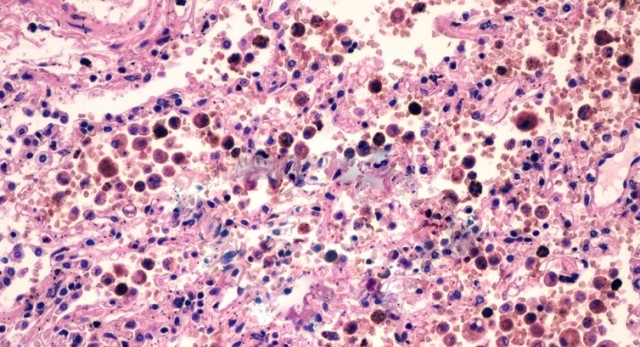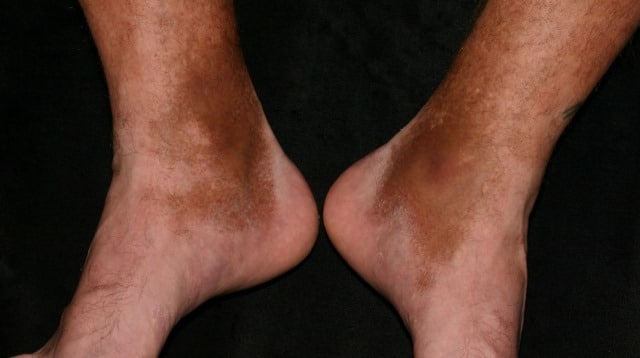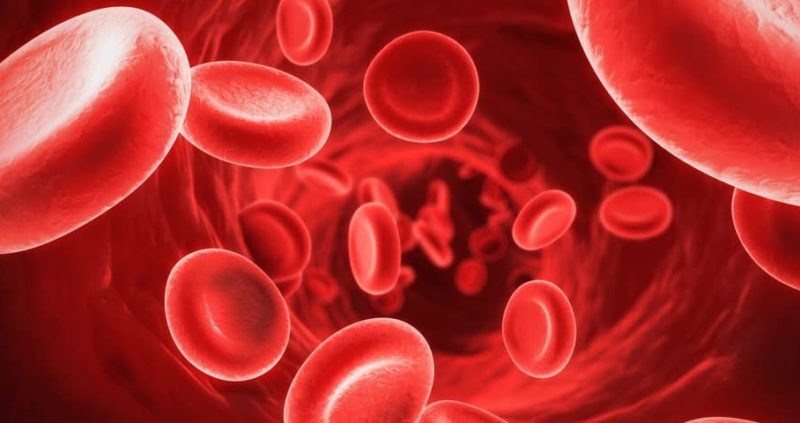Hemosiderin is an insoluble protein that contains an iron storage complex called ferritin.It is produced by the digestion of hematin .
Hematin is a derived from the hemoglobin by removal of protein present in it.This is followed by the oxidation of iron atoms by a group of cells present in the body.It has the power to engulf and absorb particles, bacteria, and other small cells.
Hemosiderin is a brownish-blue degraded and oxidized from ferritin (iron storage protein) complex. It is insoluble and stores only inactive iron in it. This is found in the different levels of cells in your body except in the blood that is circulating.
It is believed to be made up of iron oxide, some denatured protein, and ferritin.You need to understand that the iron that the hemosiderin contains is not available to the rest of your body.
Sometimes this hemosiderin can accumulate in large quantities in the system of mononuclear phagocyte cells which comprises mostly of your white blood cells.
In some cases, this iron storage complex is found to accumulate in major organs like kidneys, liver. This might have some serious consequences like organ damage.Hemosiderin is believed to be produced by macrophages in abundance as a result of a hemorrhage (bleeding).
It is believed by scientists that hemosiderin can be a consequence of phagocytosis, which is ingestion of bacteria and other materials by phagocytes.
This post will help you get an idea about the function of hemosiderin, what happens when it begins to stain or deposit on organs and tissues, what is the cause behind it and how you can manage it through treatments
Table of Contents
How Is Hemosiderin Formed?

Hemosiderin is formed when the blood vessels in the body undergo rupture during which the blood vessels’ rupture the red blood cells in the blood will also die.
The hemoglobin, a component of the blood and also the precursor of hemosiderin will be released into space around.
The mononuclear phagocyte system also is known as the recticulo-endothelial system consisting of the cells specifical macrophages with phagocytic properties will absorb the hemoglobin that has been released in the body resulting in the formation of biliverdin and hemosiderin.
Hemosiderin is formed when the Fe++ ion gets transformed into the Fe+++ ion. In general, the Fe++ ion gets absorbed more quickly than the Fe+++ ion as it is poorly absorbed and will linger long after the bruise has reabsorbed.
What Does The Hemosiderin Do?
The most important function of the hemosiderin is to do the repairs that the body demands after an acute hemorrhage.
Another function of the hemosiderin is preventing the body from accumulating high levels of iron that is unbound iron or free iron inside it by corralling the inactive free iron inside cells of spleen, liver, bone marrow and other macrophages.The free irons are not metabolically active and building up of these free ions in the body can turn out to be toxic.
What Is Hemosiderin Staining?

The medical condition where a person develops yellow and brown patches on their skin is called as Hemosiderin staining.
This condition may also cause purple and rusty pigmentation. This happens due to the death of red blood cells that iron which is stored in the tissues as hemosiderin consequently staining the skin.
Causes Of Hemosiderin Staining
Hemosiderin staining can occur in people due to the following reasons:
- Patients who have undergone surgical procedures
- In people who have suffered from hemorrhage
- Those who have cardiac problems are at high risks for hemosiderin staining.
- The breaking of the blood vessels can occur under the skin in people with high levels of blood pressure. This rupture of blood vessels may lead to modifications in the skin.
- People who have suffered from trauma like car accidents, falling from a height, etc. can develop hemosiderin staining.
- Regular injections or medical procedures like sclerotherapy, hemosiderin staining can occur as a side effect.
- People who are suffering from systemic health problems like venous insufficiency are also prone to developing hemosiderin staining.
How To Get Rid Of Hemosiderin Staining?
As soon as you observe rusty purple stains on your body go to your doctor for a proper diagnosis and he/she will suggest you the treatment best suited for your condition.
There are two most common types of treatment that your doctor might recommend to remove hemosiderin staining are as follows:
1. Topical Treatments
Applying gels, creams, lotions, ointments prescribed by your doctor will help in the reduction of the hemosiderin stain. Applying gels or creams with vitamin K oxide will eliminate the hemosiderin from the affected area. Vitamin K oxide converts Fe+++ ions back into Fe++ ions hence reversing the hemosiderin formation. A recent entry into the cosmetic dermatology market is Auriderm which contains nanoparticles of vitamin K oxide. Therefore, it is a useful tool to get rid of hemosiderin stains from the skin.
2. Laser Treatment Method
This is very effective in treating hemosiderin staining. This treatment might require a one to four sessions as it depends on the where the hemosiderin staining is located, whether on the upper part or lower part of your body. The treatment also depends on the intensity and duration of the stain and your skin type.
You’ll need to keep this in mind it is challenging to get rid of hemosiderin staining on the lower legs blood is continuously circulating in this area. So the treatments like creams, gels, and laser that I discussed before might benefit only in other areas of your body.
Hemosiderosis
Hemosiderosis is a medical condition where the iron builds up in the form of hemosiderin in different parts of your body. It is also known as hemosiderin deposition.
Types Of Hemosiderosis
There are three main types of hemosiderosis:
1. Transfusion Hemosiderosis
It develops due to the accumulation of iron in the liver, heart, and endocrine glands. This condition occurs in patients who are undergoing or have undergone frequent blood transfusion for cases like thalassemia, sickle cell, leukemia, aplastic anemia, myelodysplastic syndrome or anemia.
2. Idiopathic Pulmonary Hemosiderosis
It is also known by names like Pulmonary haemosiderosis, Brown induration of lung, Essential brown induration of lung, and Ceelen-Gellerstedt syndrome. This is a lung disease that develops due to the accumulation of hemosiderin in the lungs.
3. Transfusional Diabetes
Reasons Behind Developing Hemosiderosis
- Here are a few common diseases, disorders that can make your body susceptible to hemosiderin deposition or hemosiderosis.
- Diffuse alveolar hemorrhage is will leads the accumulation of excessive hemosiderin in the lungs.
- Goodpasture’s syndrome- A rare autoimmune condition where your immune system of your body begins to attack your lungs and kidneys body’s immune system attacks the lungs and the kidneys consequently causing bleeding in the lungs and inefficiency in the kidney function.
- Idiopathic pulmonary hemosiderosis –This is a lung disease, in which the small capillaries of the lungs rupture and begin to bleed leading to overloading of hemosiderin in the lungs.
- Mitral stenosis is a valvular heart disease where the mitral valve of your heart narrows down.
- Hemochromatosis is a condition wherein iron overloads in your entire system mainly in the liver and might cause organ failure. This disorder can be genetic a result of blood transfusion.
- Diabetes is a metabolic disease in which the blood sugar levels are consistently elevated.
- Chronicsubduralhemorrhage it is a type of hemorrhage that arises due to traumatic brain injury
- Cerebral arteriovenous malformations is a condition at the level of the brain where there is an abnormal link between the arteries and the veins.
- Cavernous hemangioma is a type of blood vessel malformation where the dilated blood vessels form a tumor.
- Bruising– the color will change as the bruise will heal (hemosiderin being removed from under the skin)
- Stasis dermatitis is a medical condition that occurs due to the insufficient venous return and the blood starting collecting in different parts of the body.
- Paroxysmal nocturnal hemoglobinuria, this is a rare but a fatal disease where the immune system begins to attack the red blood cells in your body hence destroying them.
- Conditions that require frequent blood transfusions like Sickle cell anemia (hemoglobin presents structural abnormalities) and Thalassemia ( abnormal hemoglobin formation)
The exact cause for a person to develop hemosiderin is unknown, but the above are some situations that can lead to hemosiderin deposition.
How To Get Rid Of Hemosiderosis?
After proper diagnosis and consultation with your doctor regarding your condition, your doctor might follow these procedures to manage your disease.
Phlebotomy, Immunosuppression, Limiting blood transfusions, and Iron chelation therapy are some of the conventional methods opted by many doctors.
In the case of pulmonary hemorrhage methods like Oxygen therapy, Blood transfusions, Supportive respiratory therapy, Mechanical ventilatory support, Immunosuppressive treatment is supported. Avoiding milk and dairy products, and a Gluten-free diet is recommended.
In most cases, most cases excess hemosiderin indicates an underlying problem in your body, and there are cases where the accumulation can also become fatal so make sure you consult a proper doctor and get your condition diagnosed.





